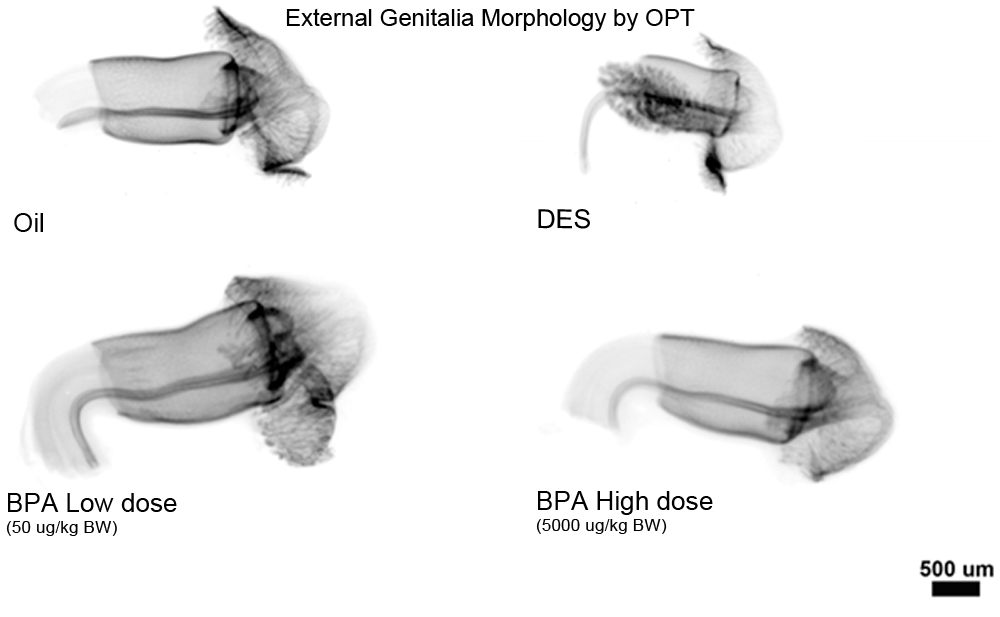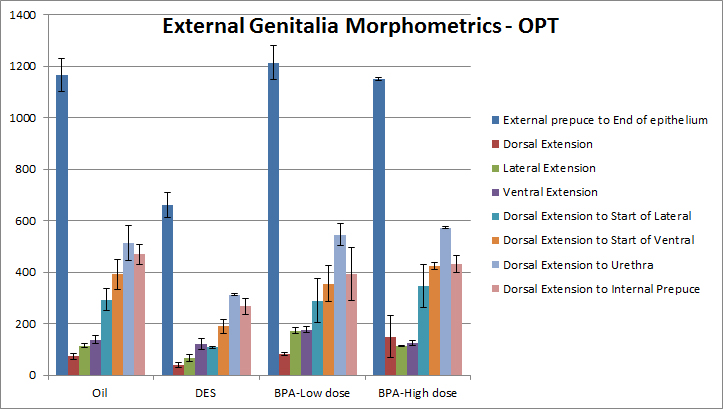-->
|
Back to 2014 Fall Congress Meeting Abstracts
Effect of Postnatal exposure to Bisphenol A and Diethylstilbestrol in inducing malformation of the external genitalia of male mice
Yi Li, BA, Sisir Botta, MD, Adriane W. Sinclair, PhD, Gerald R. Cunha, PhD, Laurence S. Baskin, MD.
University of California, San Francisco, San Francisco, CA, USA.
BACKGROUND:
The geographical variation and rise in prevalence of hypospadias has brought concern to some environmental agents, termed endocrine disruptors. These agents are not new. Previously, Diethylstilbestrol (DES) became associated with second generation malignancies. More recently, Bisphenol A (BPA) has garnered much attention. Although BPA has been ubiquitous in the plastics industry for years, the adverse effects remain controversial. We have previously described a murine model for the development of the external genitalia. Herein, we describe an investigation using this murine model to assess the effects of DES and BPA on mouse external genitalia hypothesizing that they both are deleterious for male urethral development.
METHODS:
Twelve male CD-1® mice were treated in the neonatal period from day 1 to 10 with oil, DES, and BPA (low-dose 50 ug/kg body weight (BW) and high-dose 5000 ug/kg BW). The external genitalia were dissected, fixed, and processed for staining with a monoclonal E-cadherin antibody. Optical projection tomography (OPT) was performed. Three-dimensional reconstruction images were created and analyzed. Morphometric measurements were made of the external genitalia and compared across treatment groups.
RESULTS:
Morphology was strikingly altered in the DES-treatment group. On gross visualization, the external genitalia were severely truncated and malformed, relative to the oil- and BPA-treatment groups. Specifically, the distal end of the penis, the male urogenital mating protuberance (MUMP), was shortened; additionally, the urethral anatomy was also structurally distorted (Figure 1). On morphometric analysis, the DES-treatment group displayed a consistent shortening of all mesenchymal structures measured (Figure 2). The BPA-treatment group demonstrated grossly normal morphology and internal anatomy, relative to the oil-treatment group. The erectile body structures and external genitalia luminal structures appeared anatomically intact. The BPA-treatment group demonstrated occasional slight enlargement of structures but overall appeared relatively similar to the oil-treatment group. There did not appear to be dose-response relationship between the BPA-low-dose and BPA-high-dose treatment groups. Statistical analyses of morphometric measurements using 1-way ANOVA did not demonstrate significant differences (p > 0.05).
CONCLUSIONS:
External genitalia development has been shown to be fundamentally influenced by the hormonal milieu. Environmental agents that may perturb this hormonal balance are called endocrine disruptors. We have compared the effects of multiple endocrine disruptors on the development of the murine external genitalia. The DES-treatment group exhibited significant alterations in morphology, anatomy, and morphometric measurements. The BPA-treatment groups exhibited relatively unchanged results, with occasionally enlarged morphometric measurements. The difference in external genitalia response to DES versus BPA may be due to the vast difference in the inherent estrogenicity of these two compounds. This represents the first analysis of the effects of BPA on the murine external genitalia development as well as the first analysis of murine external genitalia using OPT.
 
Back to 2014 Fall Congress Meeting Abstracts
|



